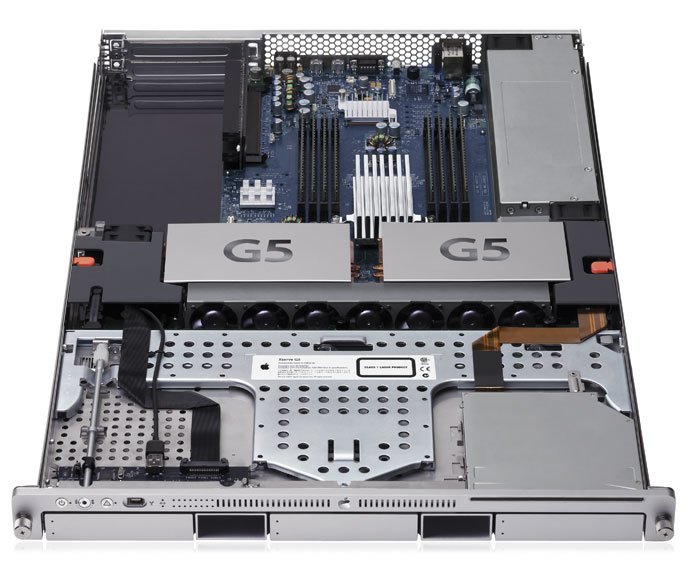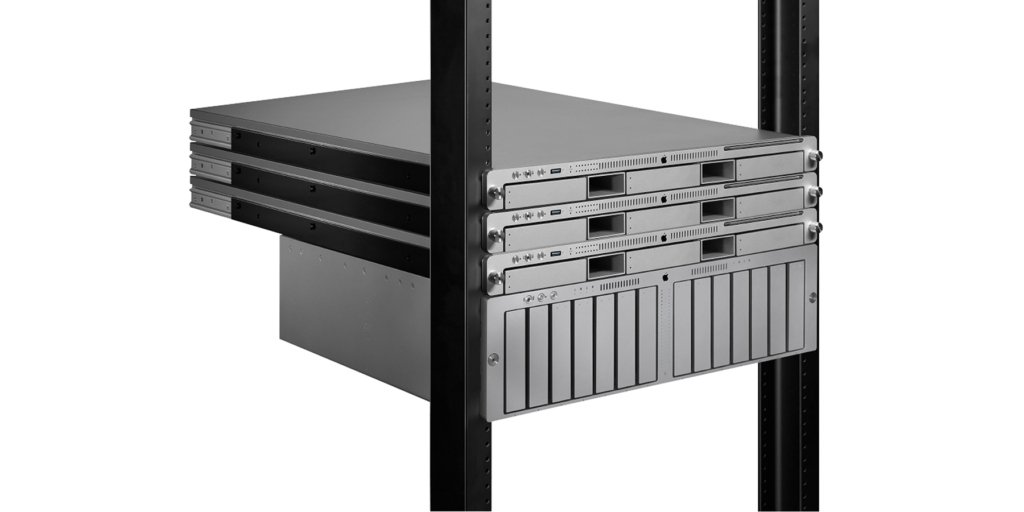In the early 2000s, Apple embarked on a remarkable journey into the enterprise market, introducing groundbreaking products like the Xserve G5. This network server computer, released from 2004 to 2006, represented a pinnacle of technological advancement and ingenuity.
Launched on January 6, 2004, the Xserve G5 Early 2004 emerged as a beacon of innovation, boasting unparalleled processing power and cutting-edge features tailored to meet the demands of modern UNIX-based applications. With its revolutionary PowerPC G5 processor, the Xserve G5 delivered over 30 gigaflops of processing power per system, a substantial leap from its predecessor.
Equipped with a new system controller supporting up to 8 GB of ECC memory, three hot-plug Serial ATA drive modules offering up to 750 GB of storage, and optional internal hardware RAID, the Xserve G5 redefined the standards of server performance and manageability. Its dual PCI-X slots and dual on-board Gigabit Ethernet ensured seamless integration into high-performance networking environments, setting new benchmarks in efficiency and reliability.
The Xserve G5’s architecture, powered by single or dual 2.0 GHz PowerPC G5 processors, showcased unprecedented computational capabilities, including symmetric multi-processing and optimized Velocity Engine. Its industry-leading front-side processor bus facilitated lightning-fast data transfer rates, enhancing overall system responsiveness and productivity.

Inheriting the engineering marvels of the Power Mac G5, the Xserve G5 embodied a fusion of power and elegance, encapsulated within a sleek 1U enclosure. Innovative cooling mechanisms, including copper heat sinks and high-performance fans, ensured optimal thermal management, guaranteeing sustained performance even under the most demanding workloads.
The Xserve G5’s versatility extended across a myriad of applications, from cross-platform file and print services to high-performance computing and web serving. Its cluster node configuration offered a cost-effective solution for computational clustering, unlocking the full potential of dual G5 processors without compromising on performance.
Apple’s commitment to user experience was evident in the Xserve G5’s enhanced management capabilities, facilitated by Server Monitor—an intuitive hardware remote monitoring application. With over 30 sensors providing real-time insights into critical system functions, administrators could ensure optimal performance and reliability with ease.
Despite its eventual discontinuation in 2006, the Xserve G5 Early 2004 remains a poignant chapter in Apple’s journey, symbolizing the company’s foray into enterprise solutions and its relentless pursuit of innovation. As we reminisce about the Xserve G5’s legacy, we’re reminded of Apple’s bold vision and transformative impact on the enterprise landscape. Though passed 20 years, the spirit of innovation embodied by the Xserve G5 continues to inspire future generations of technology enthusiasts, serving as a timeless reminder of Apple’s enduring legacy in shaping the digital age.

Xserve G5 Early 2004 Details
| Introduced | January 6, 2004 |
| Discontinued | August 7, 2006 |
| Model Identifier | RackMac3,1 |
| Model Number | A1068 |
| EMC | 1994 |
| Order Number | M9743LL/A (2 GHz) M9745LL/A (dual 2 GHz) |
| Original Price | $2,999 $3,999 |
| Colors | Aluminum |
| Weight | 33 Ibs. 14.968 KG |
| Dimensions | 1.73” H x 17.6” W x 28” D 4.39 cm H x 44.7 cm W x 71.12 cm D |
Rack Support
- Fits EIA-310-D-compliant, industry-standard 19-inch-wide racks, including four-post racks (24-inches, 26-inches, and from 29 to 36-inches deep) and two-post telco racks (center-mount brackets included)
Xserve G5 Tech Specs
Processor
| Processor | PowerPC 970fx G5 |
| Processor Speed | 2 GHz Dual 2 GHz |
| Architecture | 64-bit |
| Number of Cores | 1 |
| System Bus | 1 GHz |
| Cache | 64 / 32 KB L1 512 KB backside L2 |
Storage & Media
| Storage | 80 GB 7,200 rpm |
| Media | 1 – 24x CD-ROM or 8x DVD-R/CD-RW “Combo” drive |
Memory
| Built-in Memory | 512 MB (shipped till January 4, 2005) 1 GB shipped from January 4, 2005) |
| Maximum Memory | 8 GB |
| Memory Slots | 8 – PC-3200 DDR400 SDRAM |
| Minimum Speed | 10 ns |
| Interleaving Support | No |
Display
| Built-in Display | None |
Graphics
| Graphics Card | None |
| Graphics Memory | N/A |
| Display Connection | None |
| Display Modes | N/A |
Expansion
| Expansion Slots | 2 – PCI-X 133 MHz 64-bit |
| Bays | 3 – Apple Drive Module bays |
| Hard Drive Interface | 3 – 1.5 Gbps Serial ATA (SATA) |
| ADM Compatibility | 74 GB 80 GB 250 GB 400 GB 500 GB |
Connections
| Ethernet | 2 – 10/100/1000BASE-T (support for jumbo frames) |
| Modem | None |
| Wi-Fi | None |
| Bluetooth | None |
| Fibre Channel | Optional |
| USB | 2 – 480 Mbps |
| Serial | 1 – DB9 (RS-232) |
| SCSI | None |
| FireWire | 1 – 400 Mbps 2 – 800 Mbps |
| Audio In | None |
| Audio Out | None |
| Display | None |
Software
| Original OS | Mac OS X Server 10.3 (Unlimited Client) |
| Maximum OS | Mac OS X 10.5.8 |
| Firmware | Mac OS ROM |
| Bundled Software | None |
Power
| Backup Battery | Unknown |
| Maximum Continuous Power | 170 – 290 W |
| Line Voltage | 90V – 264V AC |
Further Reading and References
- Xserve G5: Technical Specifications – Apple Support
- Apple Introduces Xserve G5 – Apple Newsroom
- Xserve – Wikipedia
- Xserve G5 (Early 2004) – Low End Mac
- Xserve G5 – Apple History
- G5 Xserve – Sound on Sound
- Xserve G5 Review – MacWorld
Disclaimer: The data presented in this article is under continuous development and has been manually collected from various sources based on their availability. The author of this article may revise this dataset as additional research is conducted and reviewed. Please note that the information is provided “as is” and “as available” without express or implied warranties. The author cannot be held responsible for any omissions, inaccuracies, or errors in the published information. Any warranties relating to this information are hereby disclaimed.
Last updated: February 25, 2024
